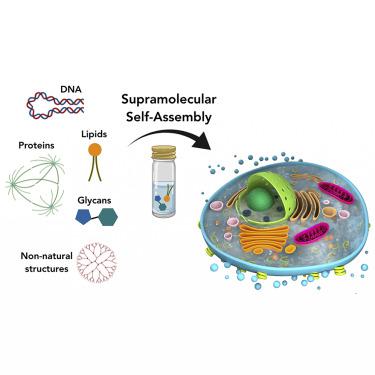Chem ( IF 19.1 ) Pub Date : 2020-06-25 , DOI: 10.1016/j.chempr.2020.06.005
Ignacio Insua , Javier Montenegro

|
One of the biggest challenges in modern chemistry is the preparation of synthetic materials with life-like behavior for the assembly of artificial cells. In recent years, numerous artificial systems that mimic cellular components and functions have been developed. Supramolecular chemistry plays a key role in such cell mimics given that non-covalent interactions control the shape and function of many biomolecules, such as DNA base pairing, protein structure, ligand-receptor binding, and lipid membrane packing. However, the complexity of living cells constitutes a major challenge for their bottom-up assembly from pure synthetic materials. Inspired by the building blocks of nature, a wide range of supramolecular systems have been developed to reproduce cellular functions such as cell-cell communication, signaling cascades, and dynamic cytoskeleton assemblies. This review surveys a selection of key advances in synthetic derivatives of biomolecules with supramolecular organization and life-like behavior by addressing their non-covalent foundation and integration as increasingly complex protocell models.
中文翻译:

栩栩如生的材料和原始细胞模型中的合成超分子系统
现代化学最大的挑战之一是制备具有逼真的行为的合成材料,以组装人造细胞。近年来,已开发出许多模仿细胞成分和功能的人工系统。超分子化学在此类细胞模拟中起着关键作用,因为非共价相互作用可控制许多生物分子的形状和功能,例如DNA碱基配对,蛋白质结构,配体-受体结合和脂质膜堆积。然而,活细胞的复杂性是由纯合成材料自下而上组装的主要挑战。受自然构造的启发,已经开发了多种超分子系统来重现细胞功能,例如细胞间通信,信号级联,和动态细胞骨架组装。这篇综述通过解决非共价基础和整合为日益复杂的原始细胞模型,调查了具有超分子组织和逼真的行为的生物分子合成衍生物的关键进展。

































 京公网安备 11010802027423号
京公网安备 11010802027423号